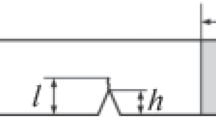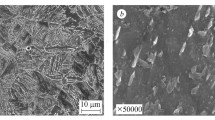Conclusions
-
1.
The fracture surfaces of steels 18Kh2N4VA and 30KhGSNA show different types of fracture.
-
2.
Homogenization by the experimental method increases the ductility of transverse samples due to reduction of the chemical microheterogeneity; the degree of anisotropy of the mechanical properties decreases from 1.72 to 1.16 for steel 30KhGSNA and from 2.26 to 1.45 for steel 18Kh2N4VA. On the microfractographs the difference in dimple sizes decreases.
-
3.
For electrochemical separation of carbon replicas we recommend 10% solution of nitric acid in ethyl alcohol at a current density of 0.5 A/cm2 and potential of 10–15 V.
Similar content being viewed by others
Literature Cited
L. G. Orlov and L. M. Utevskii, Zavod. Lab.,25, No. 9 (1959).
L. M. Utevskii, Temper Brittleness of Steels [in Russian], Metallurgizdat, Moscow (1964).
C. Crussard, Atomic Mechanism of Failure [Russian translation], Metallurgizdat, Moscow (1963).
Additional information
UkrNIIspetsstal'. Translated from Metallovedenie i Termicheskaya Obrabotka Metallov, No. 2, pp. 45–49, February, 1969.
Rights and permissions
About this article
Cite this article
Malinovskaya, T.I., Taran, A.V. Microstructure of fractures in structural steels. Met Sci Heat Treat 11, 128–130 (1969). https://doi.org/10.1007/BF00652281
Issue Date:
DOI: https://doi.org/10.1007/BF00652281




